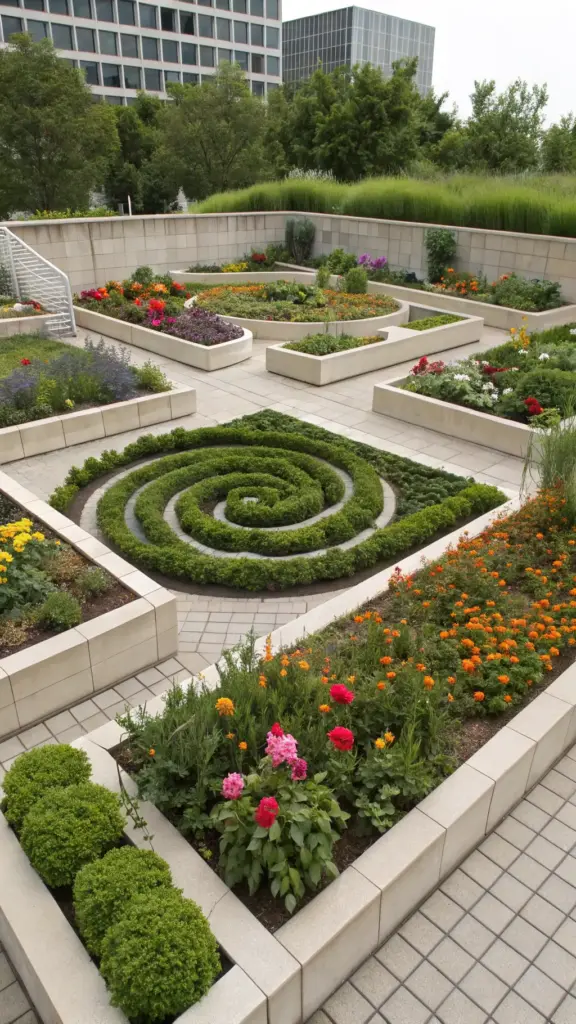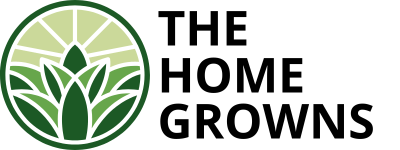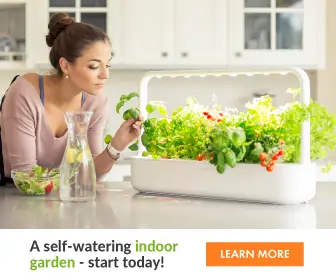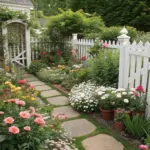8. Geometric Patterns: Modern Meets Nature

Let’s talk about something that completely changed the way I think about garden design—geometric patterns. A few years ago, I decided to break away from the usual chaotic, free-flowing layouts and tried my hand at a geometric garden. It was like giving my backyard a sleek makeover. Suddenly, my space felt more intentional, polished, and downright Instagram-worthy. If you’re ready to blend modern aesthetics with the beauty of nature, this is the style for you. Let’s dive into how you can use shapes, lines, and bold colors to create a garden that’s equal parts art and function.
How Geometric Designs Add Structure and Visual Interest
The magic of geometric designs lies in their ability to bring order to outdoor spaces. Whether it’s a spiral herb garden or a grid of raised beds, these clean lines and defined shapes add structure that feels both sophisticated and calming.
I remember walking through a friend’s garden once—it had a circular flower bed surrounded by perfectly trimmed boxwood hedges. It wasn’t just beautiful; it felt like every element had a purpose. Geometric patterns also create visual interest by drawing the eye to specific areas, making your garden feel dynamic rather than flat. Plus, they’re incredibly versatile—you can go minimalist with simple grids or get creative with spirals and zigzags.
Using Raised Beds or Hedges to Create Shapes Like Circles, Spirals, or Grids
One of the easiest ways to incorporate geometric patterns is by using raised beds or hedges. These elements act as natural borders that define your shapes while adding texture and depth. Here are some ideas:
- Raised Beds: Perfect for creating rectangular grids or circular patches. They’re also great for growing vegetables, herbs, or flowers with precision.
- Boxwood Hedges: Use these to outline geometric shapes like squares, diamonds, or even mazes (if you’re feeling ambitious!).
- Gravel Pathways: Combine gravel paths with geometric planting beds to create a striking contrast between soft greenery and hard materials.
I once used old bricks to build a spiral herb garden, and it became the centerpiece of my yard. Not only did it look amazing, but it also made harvesting so much easier. Pro tip: keep your shapes proportional to your space—a tiny circle in a large yard might get lost, while an oversized grid could overwhelm a small patio.
Pairing Bold Colors with Clean Lines for a Contemporary Look
When working with geometric designs, color is your secret weapon. Pairing bold colors with clean lines creates a contemporary vibe that feels fresh and modern. For example:
- Plant vibrant blooms like red salvias or orange marigolds in rectangular raised beds for a pop of color.
- Use monochromatic schemes within each shape—like all-purple flowers in one circle and all-yellow in another—to keep things cohesive yet striking.
- Incorporate foliage plants with bold textures, like purple fountain grass or variegated hostas, to add layers of interest.
I learned this the hard way when I mixed too many colors in one section—it looked messy instead of modern. Stick to a limited palette per shape, and let the geometry do the talking.
Tools and Apps to Help Plan Your Geometric Layout
Planning a geometric garden doesn’t have to be guesswork—there are tons of tools and apps out there to help you visualize your design before you start digging. Some of my favorites include:
- Garden Planner Apps: Tools like iScape or Gardenize let you drag-and-drop shapes, plants, and features onto a virtual blueprint of your space.
- Graph Paper: Old-school but effective! Sketching your layout on graph paper helps you map out proportions and spacing.
- Landscape Design Software: Programs like SketchUp or Canva offer advanced options for designing intricate patterns.
I used a free app last year to plan a grid-based vegetable garden, and it saved me hours of trial and error. Trust me, having a clear plan makes all the difference.
Ready to Escape to Paradise?
If you’re loving the idea of blending modern geometry with natural beauty, just wait until you see what’s next! In the following section, we’ll explore how to create a tropical oasis right in your backyard, complete with lush greenery and exotic blooms. Click the “next” button below to discover how to bring vacation vibes to your own home!









GIPHY App Key not set. Please check settings